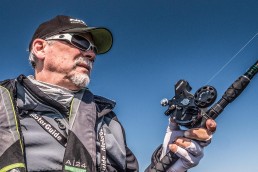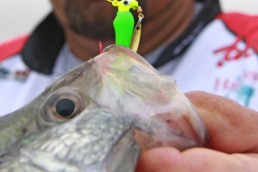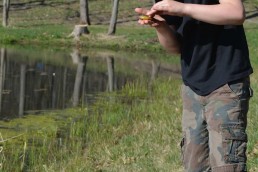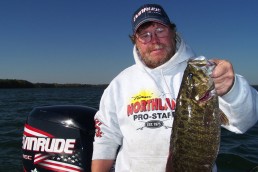Time of Transition
SHARE THIS POST
The summer peak is exactly that—a peak. Walleyes will bite anything. Jigs, live bait, crankbaits, spinners, you name it. But eventually, we find every lake has a change that signals the end of the easy days. It could be rising water temperatures, shad spawn, shiner and perch fingerlings, mayflies, or all of these at once, spreading out the fish and giving them more than their fair share of natural sustenance.
The peak starts when water temperatures hit 60 degrees. At this temperature walleyes need to feed multiple times a day due to higher metabolism. Plus, many of the food sources mentioned above are not quite established, so the lake’s grocery store happens to be a bit bare. The fish love to be in shallow warming, water and will eat anything moving at a medium speed. Jigs with a swimbait like the Berkley Power Swimmer (on a horizontal retrieve) or a fluke-style bait like the new Power Jerk Shad (on a jigging retrieve) are obvious choices. When the wind picks up, we find a crankbait like the Flicker Shad Shallow will keep tension on the line, and can lead to more hook-ups.
But that inevitable temperature rise to 70 degrees stops the party. Smaller fish take over where larger fish once roamed, and the numbers of bites drop off, dramatically signaling changes for fishermen. The lake may seem daunting, but walleyes are completely predictable. They will head towards deeper structure, basins, and will chase suspended bait. In some ways this makes it simpler—we put away the live bait and focus on two fishing methods the rest of the year—high-action vertical jigging lures and deep trolling crankbaits.
These lures work best to target fish hanging on, or suspending off of structure. With the fish inhabiting all of these areas (plus a few in shallow weeds and wind-blown points), the missing link for success quickly becomes the skill to interpret sonar readings from the Lowrance HDS. An angler who can locate fish and determine the layout of the area using C-maps and Genesis Live mapping will make the right presentation choice.
A point with localized rock piles, inside turns, and boulders calls for a jigging approach. Trolling these areas would take too much time letting out line, and the lures might not actually contact the structure. Jigging can be done vertically to specific fish, casting and working shallow-to-deep with a snap retrieve, or even strolling at 0.7 miles per hour, popping the lures off the bottom. All of these options keep the lure in the strike zone for bottom-hugging walleyes; the erratic jumping motion of the lure triggers strikes all the way until late October.
Are you enjoying this post?
You can be among the first to get the latest info on where to go, what to use and how to use it!
Empty structure is the first sign it’s time to troll. After scanning three or four deeper points, rock ledges, boulder fields, plus your favorite flat, do not push the issue. The fish have moved. This will take some serious work but will be worth it. Two things also help the situation. First, the parking lots at the boat ramps will slowly empty out, as anglers not willing to put in the time to locate the fish will find something else to do. Second, big fish will start to mix with the smaller fish, making your Facebook posts even more impressive.
Firmly focused on the Lowrance screen, we start in the area of the structure we just reviewed. We fan out into the basin looking for loosely separated fish hanging near the bottom. With the right conditions, these fish move up onto the point, but spend most of the time waiting for twilight, wind, or some other trigger. While other boats keep jigging shallower, a quick run through these fish with crankbaits on leadcore or snap weights will get fish in the boat.
If the walleyes completely vacate the area, it is time to look for fish over deeper water. Downwind basins are a good place to start. In some bodies of water, the walleyes will be visible. In others, we simply assume the walleyes will be near the bait. Put GPS waypoints over single bait balls or even huge masses of marks. Fishing literally becomes a game of connect-the-dots. Trolling details have been covered in previous articles. Basically, we use the Precision Trolling app and Off Shore Tackle planer boards to confidently troll crankbaits above the bait.
The one-two punch of jigging and trolling goes on for months. Find one pattern and it will be consistent for the long haul. It takes some work, but it’s worth it to find “the next bite.”
MWO
SHARE THIS POST
Did you enjoy this post?
You can be among the first to get the latest info on where to go, what to use and how to use it!
Parsons/Kavajecz
Gary Parsons and Keith Kavajecz are professional walleye anglers specializing in tournament fishing and walleye fishing promotions. Both are “Legendary Angler” inductees into the National Fresh Water Fishing Hall of Fame, accomplished authors and co-hosts of the popular The Next Bite TV show. For more info: thenextbite.tv.



